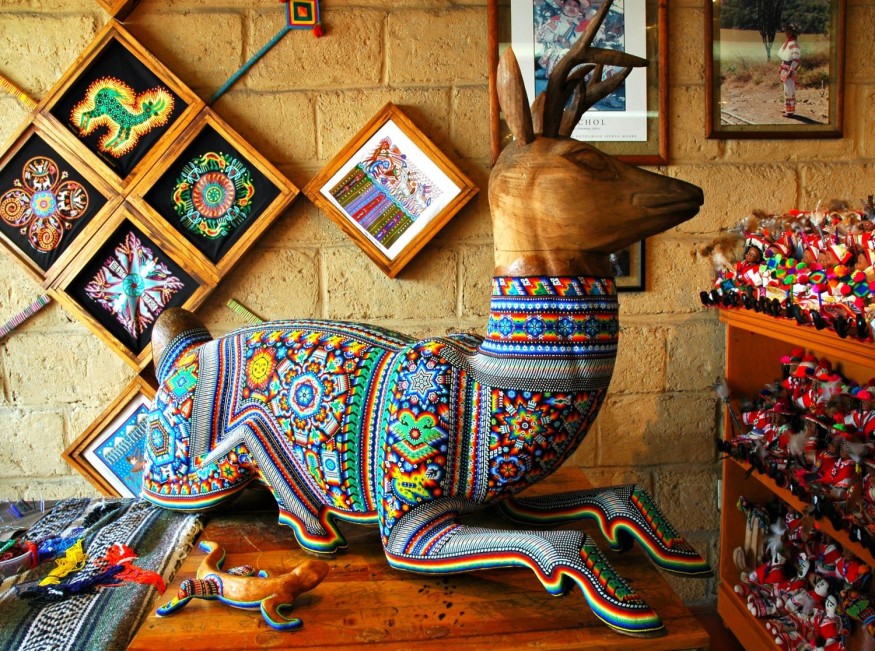Beginner’s Guide to Mexican Folk Art

Silver jewelry (Taxco)
They say one of the must haves when visiting Taxco is a piece or two of their fine jewelry, which is known as some of the finest metalwork in the Western Hemisphere.
Metalwork in Taxco goes back during the pre-Columbian times, when they are used for making intricate pieces to be used for decorative or ritual purposes. Although mining is no longer their main source of income, Taxco it is still considered as one of the most important mining areas in the region.
Textiles and woven rugs (Oaxaca)
Colorful and distinct patterns are the hallmark qualities of textiles and woven rugs made in Oaxaca. The city is a melting pot for different groups of indigenous peoples, each of whom have their own distinct style and tradition in making textiles.
While textiles and woven rugs are the most common pieces in Mexican folk art , Oaxaca rugs are still worthy to be mentioned whenever the topic arises due to the laborious work it involves.
Alebrijes (Oaxaca)
If intricacy is to be the measure of craftsmanship in Mexican folk art, the Alebrijes from Oaxaca are some of the pieces that should not be missed. Originating in Mexico City in 1936, Alebrijes are intricate wood carvings depicting animals, people, objects and imaginary creatures hand painted with bright colors and intricate patterns.
These handmade pieces are surprisingly lightweight and fragile, and must be handled with extra care.
Leather goods (Leon, Guanajuato)
We have long believed that Europe is the leather capital of the world. How wrong we all are! Shoe aficionados (the Pope included) go all the way to the city of Leon to get the best leather shoes. Leatherworking it its major industry, producing all kinds of leather goods from shoes, to bags and belts-even leather jackets.
But if you are interested in how they make their leather goods, don't expect to find schools focusing on leatherwork here. Shoemakers pass down their knowledge with their apprentices and children, keeping it a community-based industry, rather than a commercialized one.
Huichol beaded products (Jalisco, Durango r Nayarit)
The Huichol people are known for creating heavily elaborate art pieces made from hundreds of thousands of tiny, brightly colored beads. The art has evolved so much that it grew from religious purposes to a full commercial industry. They create a wide range of pieces, from dainty earrings, statement pieces to unconventional designs like heavily adorned jaguar sculptures and beaded sugar skulls.
Pottery (Oaxaca, Puebla and Jalisco)
Pottery in Mexico dates back before the pre-Columbian era, making it one of the country's most extensive art forms. The changes in Mexican pottery shows the different periods and influences that shaped the art to what it is today. From simple pots made for family use, it grew to create glazed sculptures and modern pieces using lead-free glaze to show how Mexican pottery has adapted to the times, but retained the style that has been loved over the centuries.
Oaxaca, Puebla and Jalisco pottery are regarded as the gold standard for Mexican pottery, boasting highly polished, almost artificial looking black pottery while Puebla is known for using Talavera tiles.
Hammocks (Yucatan)
To truly get a feel of local Mexican culture, make sure to buy handcrafted hammocks in the Yucatan region. Known for its durability and practicality, many houses in Mexico have built in hooks where they tie their hammocks for a relaxing afternoon siesta.
Tree of Life (State of Mexico)
Intricacy is one of the hallmarks of Mexican art, and the Tree of Life from the State of Mexico is proof of that. Traditionally, these statues are focused on biblical themes, but modern design also include depictions of other tales.
For Mexicans, the Tree of Life is more than decorative pieces. They are given out as wedding gifts to ensure them good harvest not only for future children, but also for their livelihood.
Paper craft (anywhere in Mexico)
Mexico is known for its colorful and intricate art, that unassuming pieces, like paper artwork, are easily overlooked by travelers who are new to Mexican art. Mexican paper craft vary from bright paper flowers used to decorate tombstones and altars, to custom made paper flags. Maybe it's because papercraft did not really start out as an art form, rather for documenting daily life during the Mayan era. It is only recently that paper crafts are getting attention as delicately laser cut banners used to decorate buildings and houses.
Hand-blown glass (Tonala and Tlaquepaque, Jalisco)
Colorful Mexican art goes with anything: from clothes and accessories to our homes and dinner tables. Hand blown glass is a favorite among locals and tourists because of its practicality. Producing hand blown glass involves special techniques to create unique pieces such as margarita glasses and wine goblets.
Glass makers use a 500-year-old technique, that involves blowing into a long hollow pipe through a blob of molten glass. By constantly turning the glass over, a shape is formed. From community-based art, hand blown glass art has grown into a full blown industry that enjoys unparalleled success.
Subscribe to Latin Post!
Sign up for our free newsletter for the Latest coverage!
© 2025 Latin Post. All rights reserved. Do not reproduce without permission.














